|

Another Treat
Martinu's 'Mirandolina' at Garsington Opera,
by RODERIC DUNNETT
One of the pleasures of Garsington's new foray into the operas of Bohuslav Martinu, the fiftieth anniversary of whose death falls this year, is reading the taut, hugely informative programme note on the composer's operatic output by the doyen of Czech specialists, Jan Smaczny.
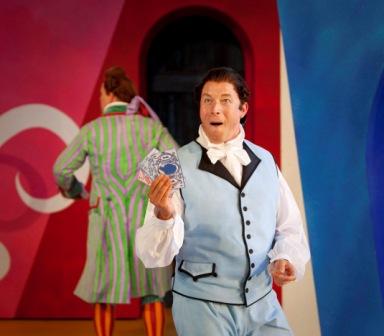
Daniel Norman's Fabrizio, who beats Andrew Slater's Forlimpopoli to win Juanita Lascarro's sophisticated, heart-of-gold innkeeper. Photo © 2009 Johan Persson
|
Not least does he make the point that Martinu, while admiring his Czech predecessors -- Dvorák, Fibich, Foerster (whose 150th also falls this December) and Novák, looked to other sources -- notably the Baroque and earlier -- to fire his comic operas, of which, from the Plautus-inspired Soldier and Dancer (1928) onwards, there are several amongst his fourteen or so operas.
Often criticised as a stylistic fly-by-night, Martinu was a skilled craftsman and adept mixer of styles, whose talents -- as one might expect of one who spent a good bit of his life in Paris and later the United States -- extended, like those of Les Six, to jazz, film and other modern idioms, from which he periodically created his own brilliant krasis, or vital mix of genre.
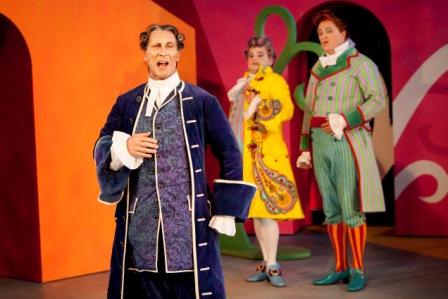
Geoffrey Doulton as the Cavaliere of Ripafratta (foreground) with Mark Wilde as the Count of Albafiorita and Andrew Slater as the Marquess of Forlimpopoli. Photo © 2009 Johan Persson
|
Mirandolina lies latish in an output that included his substantial four-parter The Plays of Mary ('Hry o Marii'), the exquisitely Kafkaesque socio-political satire Comedy on the Bridge (after Klicpera), or the extraordinarily surreal Julietta (after Neveux), which David Pountney mounted ingeniously for Opera North before moving on to stage Martinu's last opera The Greek Passion (Kazantzakis) for the Royal Opera. The sheer range of libretto sources here, mixed with his own literary and dramatic passions, confirm the range Martinu achieved in his not overlong lifespan, bridging many of the post-First World War fashions and '-isms' yet reaching right up to embrace the past half-century.
Mirandolina, in three acts, was not seen till May 1959, when it was staged at Prague's Narodni Divadlo (National Theatre) just months before the composer's death the following August. But it was composed in 1953-4, and its close timing after the première of the Stravinsky-Auden The Rake's Progress (which this company staged triumphantly only last year) may not have been entirely coincidental.
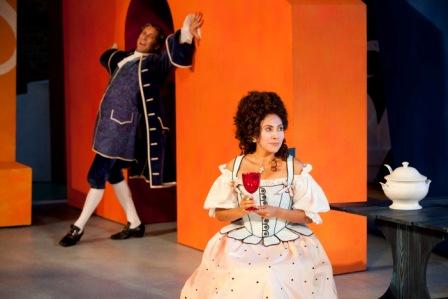
Ripafratta (Geoffrey Doulton) in hot pursuit of Mirandolina (Juanita Lascarro). Photo © 2009 Johan Persson
|
Where Martinu scores -- and it was easily apparent with a cast as natty and astute as Garsington's -- is in the ensembles: set piece duets and tightly-knit groupings which suddenly take off like Baroque arias, whether for the two foppish aristocrats (a marvellously on form Andrew Slater and Mark Wilde) vying for the central character's hand, her interaction with their unlikely misogynistic rival (the splendid Geoffrey Doulton, in one of his sharpest, crotchetyest roles to date) or the super larger ensembles with two visiting poseuses (Mary Hegarty, Jean Rigby) thrown in for little reason but good measure. The Act III finale itself, where characters turn to the audience, could be pure Rake's Progress, and you can feel Stravinsky's polished example hovering over Martinu's pen several times during the evening.
Fun apart -- and there are lots of high jinks in this Mirandolina -- the question nonetheless arises, what about the point of the drama? The opera is founded on La Locandiera ('The Innkeeperess'), a play of Goldoni's from approximately 1750-52 which Mozart's rival Salieri scored a marked success with, and which typifies Goldoni's place on the cusp of a transition from funny but hackneyed Commedia dell'arte to the more sophisticated dramatic and character insights which became a feature of the Enlightenment both in France and elsewhere in Europe.
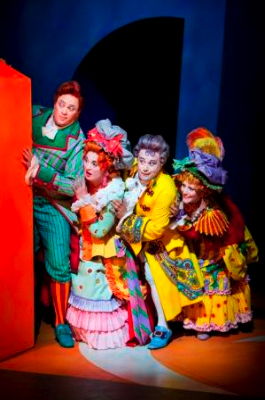
A cheeky line-up - Andrew Slater, Jean Rigby, Mark Wilde and Mary Hegarty. Photo © 2009 Johan Persson
|
One relished the orchestral buzz (some wonderful woodwind chorus and individual detail from the Garsington Opera Orchestra in a very keyed-up delivery under Martin André); was impressed by neat transitions from the declaimed or sotto-voce spoken to the sung; and teased -- at the outset, anyway -- by the witty, impudent, in-your-face Commedia presentation by director Martin Duncan and his designer Francis O'Connor, who packed the Garsington loggia stage with bright colours and curious, mock-Italian, Renaissance-cum-modern angular shapes -- triangles and blocks, rather too often and unnecessarily shifted around -- which gave a crossed feel somewhere between Cubist Piper pastiche (The Quest), Renaissance Italian art and Salvador Dali. Yet given the delicious garishness of the costumerie and perruquerie (Slater's and the bumptious ladies' attire not least), the Garsington loggia itself -- especially in a year when we are to lose sight of it, operatically speaking, for ever -- would have done very nicely, thank you.
But Goldoni (1707-1793), like Molière or Beaumarchais, or indeed Metastasio in the tragic genre, actually has something to say: about class, about social expectations, about individual mores, which I'm inclined to think go rather deeper than either Martinu, with his quick-stitched selection of scenes, or this staging penetrated. Indeed it has been observed that as well as marking a transition from his Venetian dialect plays to more widely-used Italian, 'tra tutte le opere di Carlo Goldoni, La Locandiera è sicuramente la più morale, la piè utile e la più istruttiva'. Here the antics of the impotent beaux, Forlimpopoli and Albifiorita, while beautifully and chirpily executed, become facile and wearisome: even the splendid Doulton's pithier Cavaliere, Ripafratta, who makes most headway, is reduced to a series of repetitive pastiche gestures. There has to be something more.
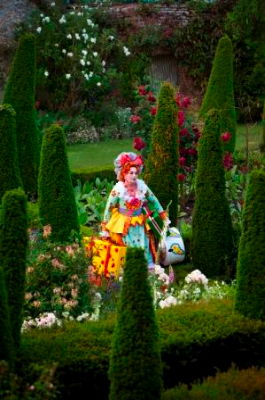
Jean Rigby's Deianira emerges, aptly, from Garsington's Italian garden. Photo © 2009 Johan Persson
|
If there was something more, it lay partly in the contrast between the established aristocracy and Doulton's usurping middle-class self-made eques, and in the shrewd personality and instinctive naturalness of the object of their affections, Juanita Lascarro's appealingly sung Mirandolina. Her final, somewhat unsignalled yet Mozart-like choice, of the humble lackey Fabrizio (a wonderfully empathetic Daniel Norman) over all the more moneyed suitors, obviously makes its mark; so do her dealings with Australian and Solti Academy alumnus Stuart Haycock, rather engaging (though with scant amount to sing) as the Cavaliere's servant.
So what figured among this adventuresome Garsington production's undoubted delights? The set pieces I have mentioned: Wilde is one of the most gifted tenors of his generation, and Slater one of the most characterful and accomplished baritones of his. The quality of their words, particularly Slater's, brilliantly enunciated so as to make the most of a responsive acoustic (here the set does help) was scarcely betterable, the vocal line of each lay ideally under their voices, and if anything helped establish the work's mock-Baroquerie, those two did.
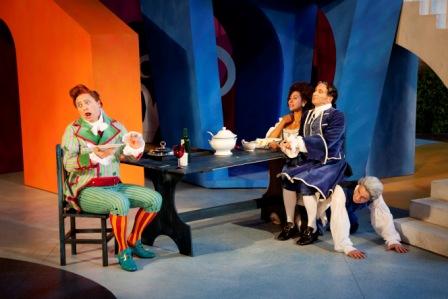
Andrew Slater, Juanita Lascarro, Geoffrey Doulton and Stuart Haycock in Garsington's 'Mirandolina'. Photo © 2009 Johan Persson
|
One enjoyed the town-band banter of the overture, with snippings from Martinu's famously jocular La Revue de cuisine thrown in to mix, amid deft woodwind and chuntering side drum (much in evidence in this opera) with shades of Auric and (all but) Monsieur Hulot's Holiday. Martinu's skittering between keys, multifarious cadencing and umpteen stylistic manoeuvres -- Schnittke might have called it polystylism, and it's one of the things that makes him seem a slightly elusive composer to some -- were like a glittering brooch, an almost Klimtian audial experience. He never seems to run out of ideas, with the result you can (but don't have to) end up slightly exhausted. Milhaud is an obvious parallel -- where again, undoubted brilliance is matched by almost indecipherable fluency.
Lascarro's arioso-like early aria was electrifyingly well sung, and the orchestra's vitality induced the usual Garsington reaction: birds in the surrounding trees joined in. At several points we seemed to be in the world of the instrumental serenade, as well as the light-hearted Baroque serenata: there was a gorgeous flute-led interlude, with clarinet joining in; another with beautiful woodwind chorus before the return of Doulton's now crazed Ripafratta (the orchestration of the subsequent courting scene had to be heard to be believed -- another area where Martinu, who could have joined those writing for Hollywood, incessantly shows his adroitness); and one utterly bizarre comic scene in Act II -- again, a lively ensemble -- outshone even the Act I quartet, and signposted the brilliance of the post-interval finale.
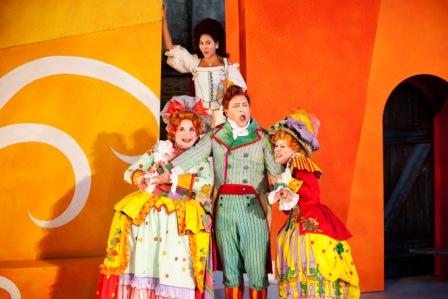
Jean Rigby, Juanita Lascarro (above), Andrew Slater and Mary Hegarty in 'Mirandolina'. Photo © 2009 Johan Persson
|
Hunting for like contemporaries, one surmises that, quite apart from its teasing echoes of Baroque Strauss -- Ariadne (Zerbinetta's strolling players) for the two girls' arrival, the other Greek myth opera Baroquisms (mostly seen at Garsington under Elgar Howarth to splendid effect in recent years) plus the posturings of Capriccio -- this kind of pot-pourri, which it certainly is, has something of the piquancy of, say, Lennox Berkeley, whose opera The Dinner Engagement has recently enjoyed some revival and a recording and engages in a not dissimilar flurry of pastiche.
Act III was arguably the best of them all. The ironic little scene in which Fabrizio and Mirandolina finally engage at a deeper level was pure joy, with Daniel Norman pulling off a kind of Simon Callow display of comic reactions and revealing a versatility beyond that with which one usually associates this beautifully articulate and melifluous Baroque-to-Britten singer. Their subsequent exchange was almost pure Janácek, and André rose even further to the occasion by making the music excitingly heated here, as also for the almost scherzoid duet between Mirandolina and the hopeless cavaliere. One small dance like a Baroque galop was a deftly executed as the little set blocks and predictable-cum-unpredictable visual line-ups Duncan brought off in the earlier acts. And that Stravinskian finale, with its rueful reflection on 'the wild ways of women', was pure heaven.
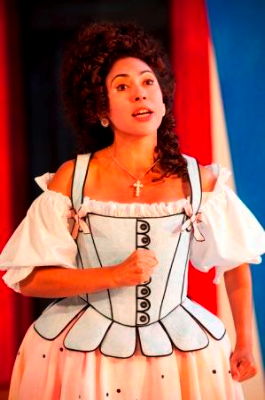
Juanita Lascarro in the title role of Garsington's staging of 'Mirandolina'. Photo © 2009 Johan Persson
|
Not a perfect opera, but another treat from Garsington's ever-inventive dressing-up box, which one hopes will continue as bold and exploratory as ever with the move to the (as yet unannounced) new venue.
Copyright © 30 June 2009
Roderic Dunnett,
Coventry UK

Tickets are available for Martinu's Mirandolina on Thursday 2 July and Sunday 5 July 2009 at Garsington Opera. Call the box office on +44 (0)1865 361636. |
GARSINGTON OPERA BOHUSLAV MARTINU MARK WILDE FRANCIS O'CONNOR CZECH REPUBLIC UNITED KINGDOM
|

